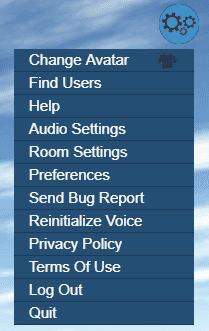About the User Preferences Menu
Onyx Education
Last Update 3 years ago
The preferences menu is where you can make changes to how the software looks, feels, and operates on your computer hardware. It is accessible through the cog menu at the top right of the Virbela screen. Select the cog and within that drop down menu, select “Preferences”.

Audio Settings
Environmental Sounds Volume: This slider allows you to set the volume of environmental sounds within the world. Environmental sounds consist of sounds that reflect your environment such as birds chirping outside or wind blowing in the forest area.
UI Sound Effects Volume: This slider allows you to set the volume of the user interface sounds within the world. User interface sounds consist of user join/leave notification noises or the sound when you receive a message.
Enable user join/leave notification: Checking this box enables a notification sound every time a user joins or leaves the room you are in. Unchecking this box will turn those sounds off.
Enable text chat notification: Checking this box enables a notification sound every time a user posts in a public chat for the room you are in. This sound will also occur when a user posts in a private volume chat while you are in the private volume or when a user sends you a private message. Unchecking this box will turn those sounds off.
Mute environment sounds in private volumes: Checking this box will mute sounds when you are in a private volume. Unchecking this box will unmute the environmental sounds in a private volume.
Directional Voice: Checking this box will turn on directional voice. While it is on, anytime a user speaks to you in the world, you will hear their voice from the direction that their avatar is standing in relation to your avatar.
For example: If I was wearing headphones and someone in the world that was standing to the left of my avatar said “hello”, I would hear their voice mostly in my left headphone. Unchecking this box will make it so all voices are heard evenly in both headphones.
User Interface Options
Show my username: Checking this box will allow you to see your username displayed above your avatar’s head. Unchecking this box will make it so you can no longer see your name, but you will still be able to see other users’ names above their heads.
Show the minimap: Checking this box will turn on the minimap that appears in the bottom right-hand corner of the Onyx University screen when you are in the campus. Unchecking this box will deactivate the minimap.
Graphics Options
Quality: The quality choices include four different options ranging from ‘Fastest’ to ‘Best’. Selecting “Fastest” will make sure your computer knows to sacrifice things like high frame rates or smooth graphics in favor of making sure the software runs smoothly in function. Selecting “Best” will ensure that all settings will run at the highest quality possible. This will use a lot more computing power and is only recommended for computers with higher quality hardware.
Target Framerate: A framerate is the number of frames that pass every second during movies, animations, and games. The options available in Virbela are 10, 20, or 30 frames per second. At 10 frames the movement on screen may appear choppy or it may stutter. The higher you go in framerate, the more frames you get and the “smoother” the movement will seem.
Font Scale: The font scale will adjust the size of all text in the Virbela menus and within the chat box. By default the font size will be set to 100%, which is the smallest available size. Any other percentage will increase the font size.
Low draw distance: Checking this box will make it so you are only able to see objects up to a certain point of distance. Not having to render the items past that distance reduces the amount of power your graphics card needs to run the software.
Enable Theme: Checking this box will allow you to see the different “themes” that will be present in the campus during special times of the year such as holidays or celebrations. We recommend you keep this box checked.
VR API: If you are using Virbela with a VR Headset, you can select what type of headset you are using to ensure the software and the device communicate properly.
Avatar Complexity: By default, your avatar complexity is set to “Dynamic”, which means that other players in your view will switch to flat avatars once too many are on the screen at once or when they reach a certain distance from you. Switching to simple avatars will make all other players into flat avatars, regardless of distance. Switching to full will make it so avatars are always displayed in full detail and may affect software performance when there are a high volume of users in the space.
Language Options: Here you will be able to select what language you would like the software to reflect.

